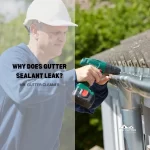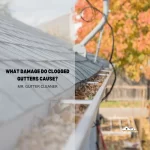Identifying the signs of roof damage early can save homeowners from costly repairs and maintain the structural integrity of their homes.
Roof damage often starts subtly, with signs such as missing or cracked shingles and minor leaks. Ignoring these issues can lead to more significant problems down the line.
Weather conditions like heavy rains, strong winds, and extreme temperatures are common culprits, alongside natural wear and tear over time.
Furthermore, inadequate roof installation or neglectful maintenance practices can exacerbate or accelerate the deterioration process, potentially leading to more severe structural issues over time.
This introduction outlines key indicators of roof damage, emphasizing the importance of regular inspections and maintenance.
By understanding these signs, homeowners can address problems promptly, ensuring their homes remain safe and secure.
The discussion also hints at how clogged gutters can contribute to roof damage, underscoring the interconnectedness of home maintenance tasks and the vital role of gutters in preserving roof health.
What Causes Roof Damage?
Roof damage stems from a mix of environmental, material, and human factors, crucial for homeowners to address for preserving their home’s integrity.
The Impact of Weather on Your Roof
Weather conditions, including storms, hail, and extreme sunlight, play a pivotal role in compromising roof integrity. These elements can strip shingles, puncture materials, and lead to the gradual degradation of the roof’s protective capabilities.
Table of Contents:
- What Causes Roof Damage?
- Sign 1: Missing Shingles
- Sign 2: Cracked or Curling Shingles
- Sign 3: Sagging Roof
- Sign 4: Water Damage in the Attic
- Sign 5: Dark Streaks and Stains
- Sign 6: Moss and Algae Growth
- Sign 7: Granules in the Gutters
- Sign 8: Peeling Exterior Paint
- Sign 9: Increased Energy Bills
- The Link Between Gutters and Roof Damage
Natural Wear and Tear Over Time
The natural aging process subjects roofs to wear and tear, manifesting as material breakdown and the diminishing effectiveness of protective granules. Regularly assessing aging signs is essential for timely maintenance and repair, extending the roof’s service life.
Poor Roof Installation and Maintenance
Faulty installation and inadequate maintenance significantly reduce a roof’s durability. Gaps from improper fitting and overlooked minor damages escalate into major issues, underscoring the importance of professional installation and routine checks to maintain roof health.
Sign 1: Missing Shingles
Missing shingles are a common indicator of roof damage, often leading to leaks and further structural issues if not addressed promptly.
Why Do Shingles Go Missing?
Shingles can go missing due to severe weather conditions such as high winds, heavy rain, or hail. Age and wear also contribute, as older shingles become brittle and more prone to detachment.
How to Spot Missing Shingles
Homeowners can spot missing shingles by looking for bare spots on their roof or finding shingle debris in gutters or around the home. Regular roof inspections, especially after extreme weather events, are crucial for early detection and repair.
Sign 2: Cracked or Curling Shingles
Cracked or curling shingles are critical signs indicating roof deterioration. These conditions typically result from environmental wear, poor attic ventilation, or material failure. Recognizing them early can prevent water damage and extend roof longevity.
What Causes Shingles to Crack or Curl?
Shingles crack or curl due to weathering, inadequate ventilation, or improper installation.
Exposure to extreme temperatures and sunlight deteriorates shingle material over time, leading to cracking and curling.
Identifying Cracked or Curling Shingles
Identify cracked or curling shingles by visually inspecting your roof for signs of aging or damage.
Look for missing granules, curling edges, or cracks on the shingle surface.
Sign 3: Sagging Roof
A sagging roof is a serious concern, indicating structural issues that may compromise the safety and integrity of a home.
The Dangers of a Sagging Roof
A sagging roof suggests potential failure points in the home’s structure, risking water infiltration, decreased insulation effectiveness, and eventual collapse if not addressed. It’s vital for homeowners to recognize the gravity of roof sagging as an indicator of underlying problems that could lead to significant damage and expense.
Causes of Roof Sagging
Several factors contribute to roof sagging, including prolonged exposure to heavy snow or water, which adds excessive weight to the roof structure. Aging support structures and inadequate roofing materials or installation can also lead to sagging. Identifying the cause is crucial for implementing the appropriate repairs to prevent further damage and ensure the roof’s longevity.
Sign 4: Water Damage in the Attic
Water damage in the attic is a clear sign of roof issues that can lead to more serious problems if left unchecked.
Linking Attic Water Damage to Roof Problems
Water damage in the attic typically indicates compromised roof integrity, where leaks or condensation are often the culprits. These leaks can stem from various roof damages, including missing shingles, cracked flashing, or inadequate sealing around vents and chimneys. Early detection and repair are crucial to prevent structural damage, mold growth, and insulation problems
Spotting Water Damage in the Attic
Homeowners can identify water damage in the attic by looking for wet insulation, stained wood, rust around nails, or mold and mildew presence. Regular attic inspections, especially after heavy rainstorms or melting snow, are essential for catching and addressing these signs of water damage early, safeguarding the home from further harm.
Sign 5: Dark Streaks and Stains
Dark streaks and stains on a roof are not just an aesthetic issue; they are indicators of potential roof damage that homeowners should not ignore.
What Causes Dark Streaks on Your Roof?
Dark streaks and stains typically result from algae growth, which thrives in moist environments. Roofs that are shaded or retain moisture, especially in humid climates, are prone to algae infestation.
This growth can compromise the integrity of your shingles over time, leading to further roof damage.
Health Risks Associated with Roof Stains
Beyond structural concerns, the presence of algae and mold can pose health risks, particularly for individuals with allergies or respiratory issues. It’s essential to address these stains not only to maintain the roof’s longevity but also to ensure a healthy living environment.
Regular roof cleaning and maintenance are key to preventing the buildup of these potentially harmful organisms.
Sign 6: Moss and Algae Growth
Moss and algae growth on roofs is not only a common sight but also a potential indicator of underlying moisture issues that can lead to significant roof damage over time
Is Moss Harmful to Your Roof?
Yes, moss can be harmful to your roof. It retains moisture against the roofing material, which can lead to wood rot and the degradation of asphalt shingles. Over time, this moisture can compromise the integrity of the roof, causing leaks and diminishing its overall lifespan. Removing moss promptly and ensuring proper roof maintenance is crucial to prevent these issues
Managing Moss and Algae on Your Roof
Managing moss and algae involves regular roof inspections to detect early growth signs, followed by appropriate cleaning methods such as gentle washing with a moss-removal solution. It’s also important to address the root causes of moss and algae growth, which often include improving roof drainage and reducing shade over the roof by trimming nearby trees. These proactive steps can significantly reduce the risk of moss and algae-related roof damage, ensuring the roof’s durability and the home’s safety.
Sign 7: Granules in the Gutters
Finding granules in the gutters is a common yet often overlooked sign of roof wear that homeowners should take seriously.
What Do Granules in the Gutters Mean?
Granules in the gutters primarily indicate that asphalt shingles are losing their protective coating. This can happen due to normal wear but is often accelerated by weather damage or poor roof quality. The granules play a critical role in protecting shingles from UV rays and water infiltration. Their loss can lead to shingle degradation, reducing the roof’s lifespan.
The Role of Granules in Roof Protection
Shingle granules are designed to provide protection against sun damage and add a layer of water resistance to roofs. They also contribute to the aesthetic appeal of the roof by adding color and texture. Once these granules start to loosen and wash away, it compromises the roof’s ability to protect the home from the elements. Homeowners noticing granule accumulation in their gutters should inspect their roofs for further damage or consider a professional evaluation to determine if repairs or replacement are necessary.
Sign 8: Peeling Exterior Paint
Peeling exterior paint can often be a sign of roof damage, particularly when it occurs near the roofline or on roof overhangs.
How Roof Damage Causes Paint to Peel
Roof damage can lead to peeling paint in several ways. Primarily, it occurs when moisture penetrates the roofing material and enters the roof structure. This moisture can then travel to the edges and overhangs, affecting the paint. Inadequate ventilation in the attic exacerbates this issue by trapping humid air, further contributing to moisture accumulation. Over time, this persistent moisture undermines the paint’s adhesion, causing it to blister and peel.
Preventing Paint Peel with Proper Ventilation
Proper attic ventilation is crucial to preventing peeling paint caused by roof damage. Adequate ventilation helps regulate the attic’s temperature and moisture levels, reducing the risk of condensation. Homeowners should ensure that their attic has sufficient intake and exhaust vents according to current building standards. Additionally, inspecting the roof for leaks and repairing any damage promptly can prevent moisture from compromising the roof structure and, by extension, the exterior paint. Regular maintenance checks, including gutter cleaning and ensuring downspouts direct water away from the house, can further safeguard against moisture-related paint peeling.
Sign 9: Increased Energy Bills
Unexpected increases in energy bills can sometimes signal roof damage, affecting a home’s insulation and energy efficiency.
The Connection Between Roof Damage and Energy Costs
Roof damage, such as missing shingles, leaks, or inadequate insulation, can lead to higher energy costs. These issues compromise the roof’s ability to keep air conditioned or heated air inside, forcing HVAC systems to work harder to maintain comfortable indoor temperatures. This inefficiency is often reflected in rising energy bills, highlighting the need for a roof inspection and potential repairs.
How to Ensure Your Roof is Energy Efficient
Ensuring a roof’s energy efficiency involves several steps. Firstly, conducting regular roof inspections can help identify and repair damages that compromise insulation. Adding or upgrading attic insulation and ensuring proper ventilation prevents heat exchange and reduces the burden on heating and cooling systems. Additionally, considering energy-efficient roofing materials or reflective coatings can further enhance a roof’s ability to reflect rather than absorb heat, maintaining a more stable and efficient indoor environment. Homeowners are encouraged to consult with roofing professionals to assess their current roof’s condition and explore options to improve energy efficiency, ultimately reducing energy costs.
The Link Between Gutters and Roof Damage
Understanding the connection between gutters and roof damage is critical for maintaining a home’s structural integrity and preventing costly repairs.
How Clogged Gutters Can Cause Roof Damage
Clogged gutters pose a significant risk to roof health. When gutters are obstructed by debris, water cannot flow away from the roof effectively. This can lead to water backup under roof shingles, causing leaks and water damage to the roof structure and the interior of the home. Over time, persistent moisture can also lead to mold growth and rot, further compromising the roof’s integrity.
Preventive Measures to Protect Your Roof and Gutters
To mitigate the risk of roof damage from gutter-related issues, homeowners should adopt several preventive strategies. Regular gutter cleaning, at least twice a year or more frequently in areas with heavy foliage, ensures water can flow freely, reducing the risk of overflow and water infiltration. Installing gutter guards can also minimize the accumulation of debris. Additionally, inspecting gutters for signs of wear, such as rust or damage, and ensuring proper gutter alignment and slope can prevent water pooling and support efficient water diversion away from the home’s foundation and roof.


